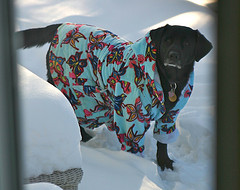There are so many reasons to love winter – snow, ice skating, Christmas lights and decorations, winter break in school – but for dogs left out in the cold, the season can turn deadly.
Dr. Carol Osborne (Chagrin Falls Pet Clinic) is a world-renowned integrative veterinarian and author. A pioneer in anti-aging medicine and longevity research for pets, Dr. Osborne created and patented the original PAAWS: Pet Anti-Aging Wellness System for dogs and cats.
She answered our questions about cold weather and dogs so you can help ensure their safety this season.
How cold is too cold for a dog?
As a rule of thumb: if it’s too cold for you, it’s too cold for your pet.
At what temperature is a dog in danger of frostbite, hypothermia, etc.?
Hypothermia and frostbite can occur whenever the dog’s body dips to an abnormally low temperature. When the dog is left out in colder weather than they are used to for too long, frostbite and hypothermia can occur fairly easily. In subzero environments it can even happen in a matter of minutes.
Normal rectal temperature in dogs & cats is 101.5 degrees Fahrenheit. Body temperatures below 96 are generally incompatible with life.
Areas most susceptible to frostbite in pets include the ears, feet, tip of the tail and the nose. Frostbitten tissue initially turns a reddish color, after which it becomes greyish-white
How to Treat Frostbite
To treat a frostbitten pet, give them a warm bath, wrap them up in warm towels, offer some warm chicken noodle soup and call your veterinarian. Be sure never to rub frostbitten areas of skin as that causes further damage.
A car heats up quickly – how fast does it cool down?
Cars tend to cool down as quickly as they heat up so it’s best to avoid leaving your pet locked in your car at any time especially with temperature extremes as when it’s very hot and very cold.

Is sticking a coat on a dog “good enough” to leave him outside?
Certainly in short-coated breeds, jackets are helpful to protect them from the cold. But be sure to keep an eye on your pet and remember when it’s too cold for you it’s too cold for your pet so be sure to bring her inside with you.
What should a person do if they see a dog left outside or in a car when it’s too cold?
Whenever you see an animal in need, become that pet’s advocate. Try talking with the owner if possible and if that fails to remedy the situation, call your local SPCA: (Society for the Prevention of Cruelty to Animals), humane society or local humane officer.
Are there laws making this illegal?
Unfortunately laws to prevent owners from leaving pets locked in cars during inclement weather have not been formally enacted but hopefully with your love and support they will be set into law.
Dr. Osborne’s Winter Tips
Finally, Dr. Osborne has some great winter tips to ensure safety of all pets in winter:
- Pets that are very young, very old, sick, pregnant or debilitated should stay indoors during temperature extremes.
- Be sure to keep deicing chemicals and antifreeze in pet proof containers placed high up out of paw reach.
- When changing your cars antifreeze, be sure pets are removed from the area and clean up any spills carefully and thoroughly. Remember just 1 teaspoon of antifreeze can be deadly to a 10 pound dog. Try “Sierra” brand antifreeze. Sierra contains propylene glycol instead of ethylene glycol as the active ingredient. It works just as well in your car but is far less deadly for your pets.
- Honk the horn and tap your car’s hood before starting up your engine this winter just in case a feline has taken up a warmer residence under your car’s hood.
- Be sure your pets have their ID tags in place with up to date, accurate information containing your name , address and phone.
- A pet 1st aid kit is a good idea and a great family project this winter. Wintertime 1st aid kit should at the very minimum contain: a blanket, towels, thermometer, Bach’s rescue remedy, as well as the phone number of your veterinarian and the phone number of the closest emergency facility.
- Last but not least, remember to give your pet a little extra love this holiday season so your pets don’t feel like they got left out “in the cold.”
About the Author
Based in Wilsonville, Ore., animal lover Kristina N. Lotz is a Certified Professional Dog Trainer – Knowledge Assessed (CPDT-KA) and works as a full time trainer. She is the founder of A Fairytail House, a unique all-positive all-sport dog training facility that helps rescue dogs in her area and provides free seminars and training classes for the community. In her spare time, she trains and competes in herding, agility, obedience, rally, and conformation with her Shetland Sheepdogs. She smartly married a Veterinary Technician, who helps keep the fur kids happy and healthy, and provides a quick resource for articles.
